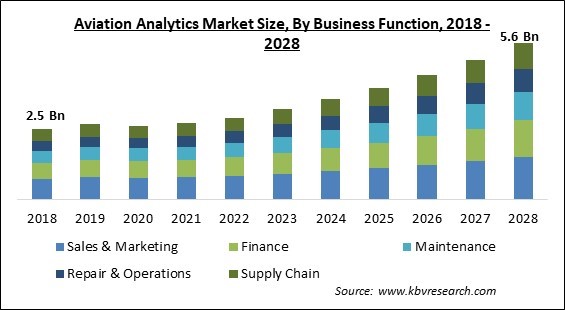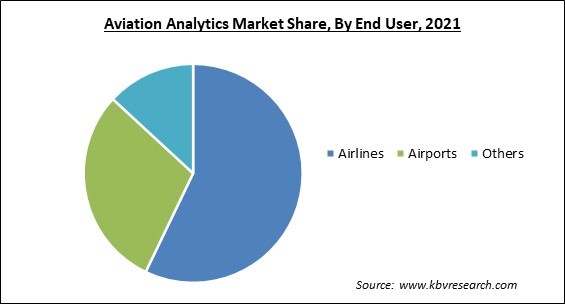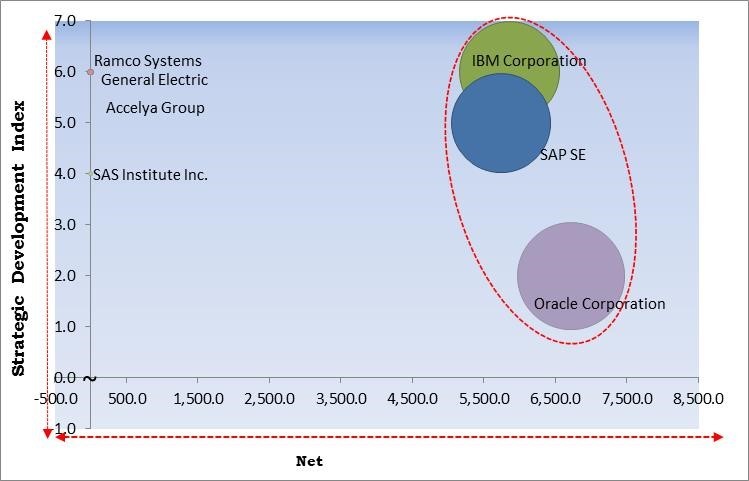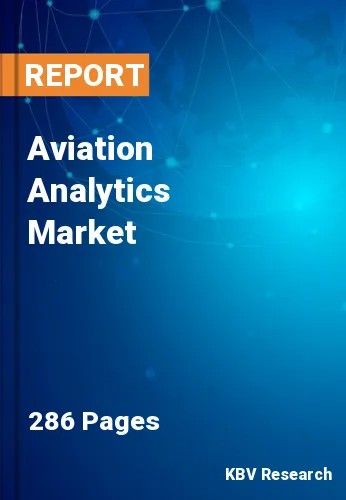The Global Aviation Analytics Market size is expected to reach $5.6 billion by 2028, rising at a market growth of 11.5% CAGR during the forecast period.
Activities related to the aviation industry and mechanical flight are included in aviation. Analytics refers to the methodical analysis of data or statistics by computation. A computational technique called aviation analytics gives end users access to historic airport operational data, weather forecasts, past flight data, and real-time flight data. It enables the processing of queries and predictive analysis on large aviation data sets. It mostly provides forecasts or answers based on enormous amounts of organized and unstructured aviation data.

The demand for crucial analytics by enterprises is driving growth in the aviation analytics industry. It aids businesses in increasing their portion of global profits. Businesses can improve performance, raise revenue and profit, and save costs associated with product manufacturing. A computational technology called aviation analytics gives end users access to data, data, or statistics on current and historical airport operations, weather forecasts, and historical & real-time flight data.
Improved results on chosen metrics are guaranteed by aviation analytics, which also offers advantages like reduced revenue leakage, efficient and effective financial procedures, and greater profitability. In order to maintain their market share on the international stage, corporations are implementing modern aviation analytics.
With the help of analytical tools, aviation companies may guarantee operational profitability and strong sales. It offers a concentrated examination of profits, sales, forecasts, and market rivalry to help businesses gather, organize, evaluate, and save the information for later use. Asset tracking, cost reduction, and downtime reduction may all be achieved with the right focus and data. Businesses may keep up with consumer trends and preferences to stay one step ahead of rivals.
Governments and organizations involved in the aviation industry have been compelled by the COVID-19 pandemic to implement a number of strict controls to stop the virus's spread. In the second quarter of 2020, airports and air traffic virtually stopped, causing drop-in airport traffic and financial losses for the aviation industry worldwide. Even though a number of nations have started to progressively reopen significant portions of their economies, many others in various regions remain vulnerable to new waves of infections, leading their governments to once again impose partial or total lockdowns.
Companies are being encouraged to use advanced data analytics by the increased competition in the aviation sector to hold onto their market share on a worldwide scale. Aviation companies can accomplish high sales and operational profitability by using data analytics. Companies can obtain, organize, analyze, store, and retrieve vast amounts of data about their markets and customers using analytical solutions like forecast analysis, sales analysis, competitive analytics, profitability analysis, and reliability analytics.
The volume of data used in the aviation sector is significant and challenging to maintain and analyze. Over 2.9 million airline passengers and more than 45,000 flights are served daily by the FAA's Air Traffic Organization (ATO) throughout more than 29 million square miles of airspace. On a single airplane, sensors gather information on more than 300,000 characteristics, with engine data being among the most significant ones. These vast amounts of data are crucial for any business decision.
A workforce with analytical skills is required with the recent increase in the usage of real-time analytical solutions including "Big Data" analytics. The lack of a skilled workforce may be able to stop the rapid growth in overall aviation passenger traffic. Additionally, despite the increase in data usage and consumption, the expansion of the aviation analytics market is constrained by a lack of skilled workers, which is a significant roadblock to existing data and analytics efforts.

By business function, the aviation analytics market is segmented into Sales & Marketing, Finance, Maintenance, Repair & Operations and Supply Chain. The finance segment garnered a significant revenue share in the aviation analytics market in 2021. Airport finance analytics covers a range of topics, including the airport's revenues, expenses, profitability, payables & receivables, profitability, assets, and important financial ratios. Owing to these factors, airports are embracing and spending in this market more and more.
On the basis of end-user, the aviation analytics market is classified into Airlines, Airports and Others. The airline segment recorded the maximum revenue share in the aviation analytics market in 2021. Airlines all around the world are using aviation analytics due to the growing demand for them in a variety of commercial applications. Some of the key reasons propelling the growth of the airline industry include the rising popularity of air travel and the introduction of new air travel routes.
Based on component, the aviation analytics market is bifurcated into Service and Software. The software segment acquired a significant revenue share in the aviation analytics market in 2021. It is due to the growing investment by companies in the adoption of advanced solutions and software. In addition, the rise in the number of players in this market is contributing to the demand for such improved products. Along with that, such software would help aviation companies to improve their operations and boost their revenue.
Based on application, the aviation analytics market is divided into Flight Risk Management, Inventory Management, Fuel Management, Revenue Management, Customer Analytics and Navigation Services. The customer analytics segment acquired the maximum revenue share in the aviation analytics market in 2021. It is due to the significant need for aviation analytics drones to meet customer needs. The airlines are making significant investments in learning about customer preferences and behavior as well as embracing customer-centricity by utilizing predictive analytics to enhance decision-making.
| Report Attribute | Details |
|---|---|
| Market size value in 2021 | USD 2.7 Billion |
| Market size forecast in 2028 | USD 5.6 Billion |
| Base Year | 2021 |
| Historical Period | 2018 to 2020 |
| Forecast Period | 2022 to 2028 |
| Revenue Growth Rate | CAGR of 11.5% from 2022 to 2028 |
| Number of Pages | 286 |
| Number of Tables | 483 |
| Report coverage | Market Trends, Revenue Estimation and Forecast, Segmentation Analysis, Regional and Country Breakdown, Competitive Landscape, Companies Strategic Developments, Company Profiling |
| Segments covered | Business Function, End User, Component, Application, Region |
| Country scope | US, Canada, Mexico, Germany, UK, France, Russia, Spain, Italy, China, Japan, India, South Korea, Singapore, Malaysia, Brazil, Argentina, UAE, Saudi Arabia, South Africa, Nigeria |
| Growth Drivers |
|
| Restraints |
|
Region-wise, the aviation analytics market is analyzed across North America, Europe, Asia Pacific, and LAMEA. The Asia Pacific garnered a promising revenue share in the aviation analytics market in 2021. The rising number of aircraft deliveries in the area can be blamed for this expansion. The region's need for aviation analytics is also anticipated to be driven by factors like the focus on enhancing aircraft safety and the improvement of aviation business activities via digital transformation. Over the last few years, the region has seen the aviation industry experience strong growth, which has been primarily fueled by improvements in functional efficiency, increased customer expectations, and increasing pressure to reduce costs across regions.
Free Valuable Insights: Global Aviation Analytics Market size to reach USD 5.6 Billion by 2028

The major strategies followed by the market participants are Partnerships. Based on the Analysis presented in the Cardinal matrix; Oracle Corporation, IBM Corporation, SAP SE are the forerunners in the Aviation Analytics Market. Companies such as General Electric, Accelya Group, Ramco Systems Limited are some of the key innovators in Aviation Analytics Market.
The market research report covers the analysis of key stake holders of the market. Key companies profiled in the report include SAP SE, Oracle Corporation, IBM Corporation, General Electric (GE) Co., Ramco Systems Limited, Accelya Group (Vista Equity Partners), SAS Institute, Inc., OAG Aviation Worldwide Limited, IGT Solutions Pvt. Ltd. and Mu Sigma, Inc.
By Business Function
By End User
By Component
By Application
By Geography
The Aviation Analytics Market size is projected to reach USD 5.6 billion by 2028.
Rising Demand for Optimized Corporate Processes Via the Use of Structured Analytical Solutions are driving the market in coming years, however, Lack of Skilled Professionals in The Sector restraints the growth of the market.
SAP SE, Oracle Corporation, IBM Corporation, General Electric (GE) Co., Ramco Systems Limited, Accelya Group (Vista Equity Partners), SAS Institute, Inc., OAG Aviation Worldwide Limited, IGT Solutions Pvt. Ltd. and Mu Sigma, Inc.
The expected CAGR of the Aviation Analytics Market is 11.5% from 2022 to 2028.
The Sales & Marketing market shows high market share in the Global Aviation Analytics Market by Business Function in 2021; thereby, achieving a market value of $1.5 billion by 2028.
The North America market dominated the Global Aviation Analytics Market by Region in 2021; thereby, achieving a market value of $2.1 billion by 2028.
Our team of dedicated experts can provide you with attractive expansion opportunities for your business.

